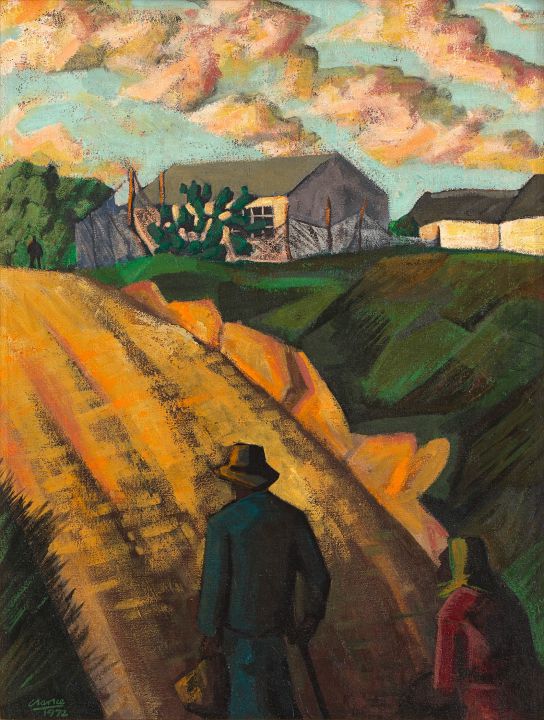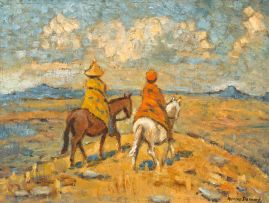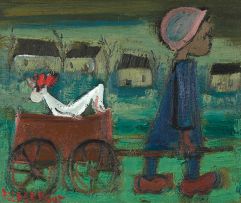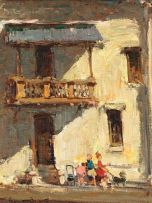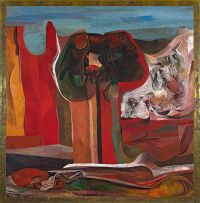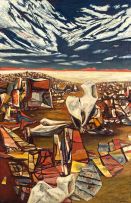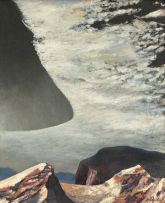Morning at Bo Plaas, Teslaarsdal, Caledon District, CP (sic)
Peter Clarke
Incl. Buyer's Premium & VAT
About this Item
signed and dated 1972; inscribed with the title and medium on the reverse
Notes
The reverse bears the following inscriptions:
"Afskeidsgeskenk van leerlinge en leerkragte Grassy Park Sekondêre Skool aan Mnr JG van den Heever met sy aftrede as Prinsipaal op 12 Desember 1983"
"To - Dear Mr van den Heever. This is not goodbye, for we'll always have fond memories of you. This is our token of our appreciation. From all your students, Grassy Park Sen. Sec. School... 1983"
The village of Tesselaarsdal is situated below the Kleinrivier Mountains near Caledon in the Overberg region. It derives its name from Johannes Jacobus Tesselaar, a wealthy landowner who in 1809 bequeathed one of his five farms to nine workers, including seven former slaves. The community was established in 1832 following the death of Tesselaar's wife and was known as Hartebeesrivier until 1930, when it received its current name. Peter Clarke first visited Tesselaarsdal in 1949. At the time he was employed as a dockworker in Simon's Town and making art in his spare time. He spent his December holidays there in 1950 and 1951. Frustrated with his life as dockworker, in 1956 he resigned and spent three months in Tesselaarsdal. Upon returning to Cape Town he sought work as a graphic artist at an advertising agency, failed in his application, and decided to become a full-time artist. Clarke continued to return to Tesselaarsdal every spring for a three-month stay until 1960.
Clarke continued to produce paintings of the rural endurance he had witnessed well after 1960. This atmospheric work from 1972 describes, with a vivid intensity and fullness of notation not seen in similar scenes produced in the early 1960s, how the rituals of life in Tesselaarsdal imprinted themselves on Clarke's imagination. "Tesselaarsdal is Peter Clarke's Pont-Aven or Le Pouldo," notes literary scholar Hein Willemse, referring to the Breton villages where Gauguin lived before his first visit to Tahiti in 1891.1 "At Tesselaarsdal he got to know the ways of the shepherds as he accompanied them on their daily rounds. The whitewashed and thatched cottages of this farming community, some dating back to 1842, signified hospitality. Here even the donkeys were afforded shelter in a cottage."2 It was a refuge during the brutality of apartheid.
This important work offers an elaboration of the role of place, people and circumstance of Clarke's luminous career. The lot was originally gifted to a school principal upon his retirement. Clarke never completed his high schooling. In 1993 he produced a well-known linocut titled For Some the Pathway to Education Lies between Thorns. It depicts five black schoolchildren walking a great distance to school. In 2013 Clarke told a London audience how his empathy for this on-going national predicament was primed by an encounter decades earlier with a group of children in Tesselaarsdal who walked a 16km round trip to school everyday.3
- Hein Willemse. (2000) More Than Brothers: Peter Clarke and James Matthews at Seventy. Cape Town: Kwela Books, page70.
- Ibid., page 71.
- Peter Clarke. (2013) From artist walkabout of his exhibition Peter Clarke: Wind Blowing on the Cape Flats, Institute of International Visual Arts, London.
